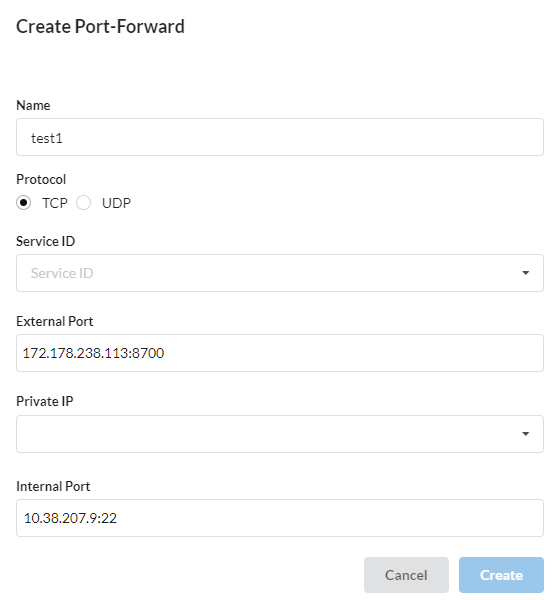Port-Forward¶
Port-Forward is a network service that allows to send external incoming traffic to some TCP/UDP port from public IP to the private IP address of your virtual machines. Usually, it is used to expose some application port (e.g., HTTPS, SSH, RDP) to the internet.
Warning
Be careful and NEVER open unsecured applications (plain-text protocols or secured with default passwords) to the internet.
Port-Forward only sends traffic to virtual machine's private IP, but Firewall (Security Groups) can block all incoming traffic. So open VM private port with Firewall's Security Group.
Port-Forward can be requested in several ways:
- In
Networkingin applicationPort-Forward; - In
Computeduring requesting a new service from catalog, selectingAdvanced Settings > Public Remote Accessrequired protocols; - In
Computefor existing service, clickNetworks > Public Access; - In
Computeby requesting separate catalog itemPort-Forward.
Roles:
- Users with role
Adminare responsible for overall security of the account, so they can view, create or remove all account'sPort-Forwards. - Users with role
Membercan view, create and removePort-Forwardonly for their own services.
Note
At the moment port-forwarding can be confiured only on primary public IP address of the account, which auto-assigned during account creation.
Port-Forward creation¶
In the Port-Forward tab, the serviсe users can view the information about port-forwards for selected location.
For port-forward in the general list, the following information is displayed:
- PF
Name; External IP and Port- public IP address;Protocol- protocole type - TCP/UDP;Servicefor PF;Internal IP and Port- private IP address of VM;- PF
Status.
To add a new port-forward, press the button Create Port-Forward.
In the dialog window, enter the name, select the protocol type - TCP/UDP and service ID, specify the External Port, private IP address and Internal Port.
Click Create.

